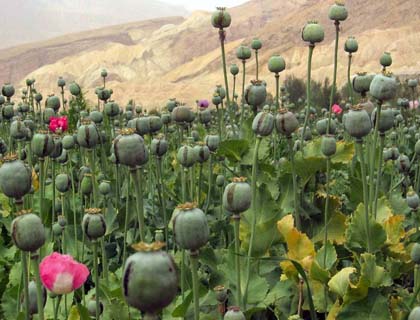It is reported that Afghanistan is the world's leading producer of opium and heroin, exporting drugs to Asia, the Middle East, Europe and the United States. But, the scale of domestic drug abuse has only recently become evident and affected the whole nation including men, women, youth and children. The opium production has risen 40 percent since last year to 6,700 tons, enough to make about 670 tons of heroin, that's more than ninety percent of the world's supply and more than what the world's addicts consume in a year.
The first nationwide survey on drug use, conducted last year by the Ministry of Counter Narcotics and U.N. office on drugs and crime who found that there are nearly one million addicts in this nation of about 30 million people, including 60,000 children under 15 years of age. The report also says that drugs ranges from hashish, opium and heroin to pharmaceutical medicines. An estimated 5,000 children are addicted to opiates, remainder take cough syrup and other drugs. The actual numbers are probably much higher, especially for the children and women. Most of the women use drugs for treatment and that has involved more women and children recently in drug addiction.
In this regard, the UN also adds that manufacture of opium soared by sixty one percent in Afghanistan from 3,600 tons in 2010, when plant disease wiped out almost half the crop yields and triggered steep price rises, to 5,800 tons in 2011. Global opium production reached 7,000 tons in 2011. The UN says that in Africa and Asia, which now account for seventy percent of heroin users, there is a clear lack of data but it is possible that there is increasing but undetected patterns of use.
In the meantime, the guardian news also adds that the number of illegal drug users is likely to grow by twenty five percent by 2050 with bulk of the increase expected to take place among the rapidly rising urban populations of the developing state nations. The U.N. office on drug and crime further adds that the biggest growth area in illegal drug use is most likely among women as cultural barriers disappear and gender equality improves.
Besides, the ministry of public health announced on late November 2012 that there are about one million drug dependents across the country who are becoming a serious security threat. Additionally, the current report released on Saturday said that about four percent of Ghazni population is drug addicted. The report further indicated that the numbers are increasing and that the numbers of 50 thousands drug users will likely increase with the passage of time that will cause further social problems if the responsible authorities do not take any initiative in this miserable phenomenon. The numbers of addicts also include women and around 47 of 1850 addicts are the women.
After all, the use of drug in the country is having a devastating impact on the economical and security areas. Drug addiction adds to insecurity, social crimes and communicable diseases and undermines Afghanistan's development efforts. The transitional threat of Afghan opium also found that the Taliban make more money from opium production now to win the war.
Additionally, this has not gone unnoticed by members of the government who now demand bribes for protecting opium farmers and traders from the law. Nor has it gone unnoticed by the Taliban, who tax opium farmers and traders to fund their war, and who use opium smuggling routes to smuggle weapons into Afghanistan. Similarly, in the areas dominated by the Taliban insurgents, the local farmers obtain protection from the Taliban, which provides the Taliban with both money and support.
A similar outcome in Afghanistan would mean a weak state constantly driven by violence and permanently threatened by insurgence. The Taliban would be well-funded and capable of attacking both the Afghan government and supporting terrorism in the world at large.
Looking at the current ground realties reveals that today Afghanistan is steeped in dozens of killer challenges. The government must come up with appropriate measurement to tackle the crises upsetting peace, stability, and progress and deteriorating the security situation and all other gains being achieved in the last 11 years with great devotion.
As of now, in Karzai's government, it shows that they are helpless to control the drug trade even in the best of circumstances. If the U.S. where billions of dollars have failed to achieve victory in the war on drugs, we cannot hope to end the drug trade in Afghanistan.
After all, the police, judicial, economic reform and other targeted development programs are most important if we are to reduce the drug addicts and opium production. Instead of nation building, the challenge of fighting corruption, the insurgency and the drug trade requires region building. The public health aspects of prevention, treatment, rehabilitation and reintegration all have to be recognized as key elements in the global strategy to reduce drug demand.
At this point of time, there are no simple solutions to a problem that has taken decades to develop. The cultivation of poppies in Afghanistan is the result of years of conflict and instability, which has been systemically exploited by drug traffickers leaving farmers with few other choices. For Afghanistan to develop a functioning economy and seek ways of survivals, it needs to focus on diversifying and strengthening its internal and regional trade.
Making progress on Afghan drugs is a challenging task for the state nations. It will take time and the commitment of the Government of Afghanistan as well as the international community to make progress and eradicate opium production. It needs strong mobilization and advocacy among all those who are producing drugs and trade it as a profession.

